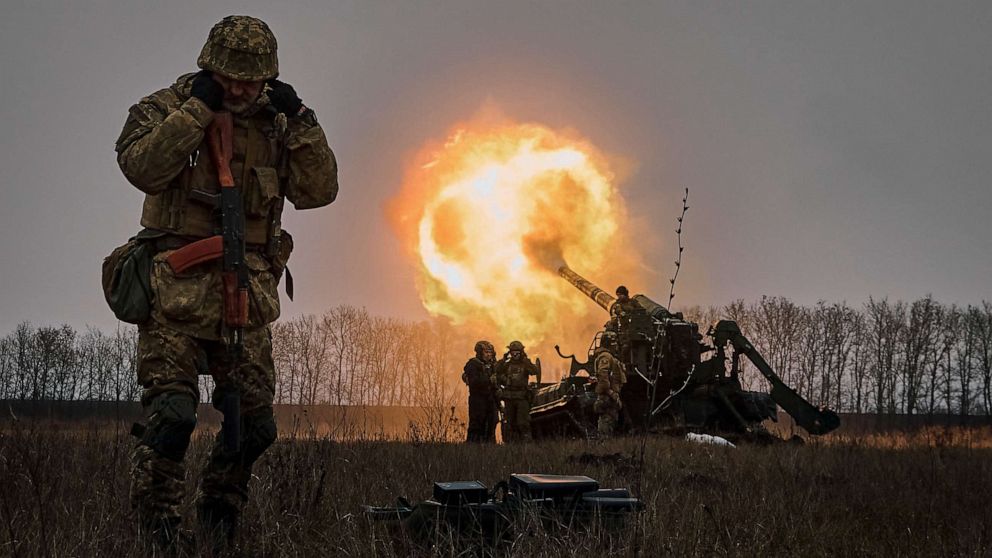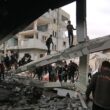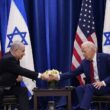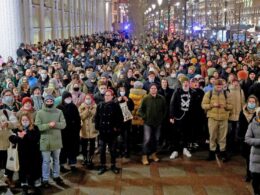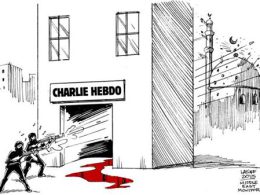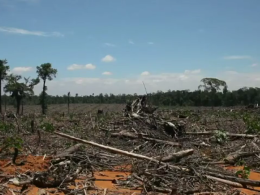By Walter Chambers
The brutal killing of Russia’s leading oppositionist, Alexey Navalny in an Arctic penal colony near to the town of Salekhard has, on the eve of the Second Anniversary of Putin’s horrific invasion of Ukraine dominated the world media. Incidentally in 1907 Leon Trotsky was sent into exile in Salekhard, then known as Obdorsk, although he managed to escape on his journey there.
Navalny’s role
Navalny joins a long list of opponents of the Kremlin who have met their death over the years, and particularly since the start of the war. The authorities refused to release the body for a funeral for over nine days, first telling his mother that he can only be buried in secret. They feared, and rightly so, that a funeral in Moscow on the eve of March’s Presidential election would turn into a protest, further upsetting the regime’s election plans. Indeed on the day, despite threats 20–25,000 turned up for the funeral, many shouting anti-Putin slogans such as ‘Down with the Tsar’, ‘Down with war’ and ‘Bring the troops home’.
Navalny came to prominence during the Bolotny protests, the largest protests in Moscow during Putin’s rule, which followed the fraudulent 2011 elections. He started his trajectory as a right wing liberal leaning on the then widespread anti-immigrant moods and far right movements with whom he actively flirted. He recognised the Russian annexation of Crimea in 2014 and introduced into his programme the demand to introduce a visa-regime with the countries of Central Asia and Caucasus, those countries where today a large part of the Russian anti-war emigration is to be found.
Whilst the other liberal leaders of that time withdrew due to repression or were sidelined due to their failed policies during the reactionary period that followed the take-over of Crimea and start of the war in Donbas war in 2014, Navalny gained notoriety with his exposures of the corruption of the ruling elite and oligarchs.
As a new generation of youth appeared who had only ever known capitalism led by Putin, he recognised they had a more left wing consciousness, and leaning on his own populist roots he gave voice to their discontent. His call to youth to come out onto the streets, first in 2017 against corruption, saw tens of thousands of youth demonstrate, and of course, many arrests. He reflected their hatred of the system, calling for the formation of trade unions, speaking out against corrupt privatisation, and even, at one stage saying he supported Bernie Sanders. At the same time, his approach was weak in that it did not develop grassroots democratic structures. During his Presidential election campaign in 2017 he organised campaign offices across the country, set up by local activists who had support from a wider layer of youth dissatisfied with the regime, but these played a purely organisational, not a political role.
His personal bravery and willingness to return to Russia after the failed assassination attempt on him inspired many. Although this approach mobilised tens and hundreds of thousands across the country, the movement was built around Navalny himself. From day one of the 2022 invasion, Navalny and his team opposed the war and called for street protests during the first days and weeks against it. But there was no clear strategy, the rank and file had no involvement in political discussion, demands and tactics were decided by Navalny and his circle. This led in the end to the defeat of the organisational structures, and to long prison sentences for local activist-coordinators. Despite his ‘left-wing’ demands and self-sacrifice, in essence Navalny remained a liberal, who strived for a ‘clean’, European-style capitalism and now his movement has turned to appeals to western imperialist powers for more sanctions against the regime’s leading figures. This strategy will not work, only by building a mass anti-war movement based on democratic structures and the workplaces, and with demands to end the bonapartist regime and the capitalist system which created it can we win.
Current situation on the front
Navalny’s death has further escalated tensions between Russia and western imperialism, and together with the capture of Avdiivka on the edge of Donetsk city and the continued Republican opposition to further US military aid for Ukraine has increased the confidence of the Russian regime. But Avdiivka was captured at a huge human cost, and, like Mariupol and Bakhmut before it, it has been left in absolute ruin. Ukrainian forces withdrew to a new defensive line when it seemed they would be surrounded to avoid further losses.
The latest figures indicate that during the second year of the war neither side won an advantage — each gained/lost 500 square kilometres. The retreat from Avdiivka has boosted Russian confidence but does not mean that Russia is getting its own way elsewhere. Ukrainian forces have maintained their foothold on the east side of the Dnieper, as well as sinking a further two ships, leaving Russia without effective control of a significant part of the Black Sea. Now Russia’s air capability has been seriously damaged with, in January the shooting down of a Russian command aircraft and an AWACS aircraft, and in the past few days a second AWACS. These aircraft are critical elements in Russia’s electronic warfare system.
Independent media sources in Russia have identified 45000 Russian troops killed, but they estimate the actual number is at least 60% higher. Zelensky says that 31000 Ukrainian troops have been killed, again this number is likely to be an underestimate. The UN High Commissioner for Human Rights reports that over 10000 civilians have been killed in the occupied parts of Ukraine, the number of Russian civilians killed mainly in the regions bordering Ukraine is in the low hundreds.
There is the appearance within the Russian regime of a new confidence, particularly as after the Prigozhin mutiny they have stepped up repression against the hardline warmongers. Prigozhin is dead, others are in prison including Strelkov who was instrumental in the annexation of Crimea and the start of the war in East Ukraine in 2014. Within the Ukraine tensions have appeared.
By May 2022, as we wrote, it was clear the war was becoming one of brutal attrition. Since then, there have been some dramatic turns — the Russian retreats from Kherson and the Kharkiv region in the second half of 2022, and the bitter battles for Bakhmut and Avdiivka, alongside the Wagner mutiny. But the most significant development of 2023 was the long anticipated Ukrainian counter-offensive that exhausted itself without any strategic or even significant breakthrough. Now that the two sides have dug into their defensive positions, throwing as much ammunition as they can at each other, the nature of the war as one of attrition is even clearer. It is clear that the Russian occupation can not be defeated by any military struggle led by the bourgeois Ukrainian regime.
Every day, Russia attacks the civilian infrastructure with missiles and Iranian supplied drones, regularly hitting schools and hospitals. Ukraine is transforming the widespread building of do-it-yourself drones in backstreet workshops into industrial-scale production, which it uses to attack oil refineries, ammunition dumps and arms factories within Russia itself. It even managed to crash a drone onto the roof of the Kremlin. When these drones fall on working class areas, as they often do now in the regions bordering Ukraine, this gives the Kremlin a new excuse for pro-war propaganda.
This underlines the warnings that socialists have made since the start of the war against illusions that a bourgeois-led military campaign could defeat the Russian imperialist occupation. The key to weaken and undermine the Russian war machine is to deepen class division within Russia itself, and especially among its troops. To do so democratically organised, armed resistance has to be combined with opposition to the capitalist policies and imperialist links of the Ukrainian government and solidarity appeals towards the Russian troops’ lower ranks and working class, based on democratic and social measures that can unify the working class in joint struggle. Such an approach is against the interests of Zelensky, and particularly those of his western imperialist backers.It can only be realised by an organised working class based on working class solidarity and the guarantee of rights for all nationalities and ethnic groups.
In the context of the New Cold War
Events in the Middle East have diverted attention from the war in Ukraine, and allowed each side new possibilities for rhetorical attacks on each other. Zelensky compares Russia to Hamas, which he says are “in essence the same”. Zelensky and the Russian liberal opposition have hypocritically supported Israel’s attacks on Gaza. Putin even more hypocritically calls for a ceasefire in Gaza, blaming the “current ruling elites of the United States and their satellites that are the main beneficiaries of global instability. They extract their blood rent from it.”
But there should be no doubt that the war in Ukraine has escalated the cold war dynamic of the bipolarisation of the world, with all its dialectical contradictions.
Taking into account the history of the Ukraine/Russia conflict with its roots in pre-revolutionary Russian imperialism, Stalinist collectivisation and the struggle between the new capitalist Russia and western imperialism, ISA has concluded that it is correct to stress the primary inter-imperialist character of the Russian imperialist invasion of 2022 and war as part of the New Cold War, also understanding that “the war is also one of national defence with Ukrainian self-determination challenged.”
Whilst the vast majority of Ukrainians see the struggle against foreign occupation and in defense of the right of self determination as primary, for many workers globally this has been obscured by the aggressive intervention of US and western imperialism with the NATO-led armaments campaign, which is intended not to protect Ukraine’s independence, but to strengthen the US position in it conflict with Chinese imperialism.
It is the working class that suffers
The working class is at the centre of this cauldron. Ukrainian workers suffer first-hand the brutal consequences of this war. They have seen their homes and workplaces destroyed, with tens of thousands of lives sacrificed and destroyed on the front while the government continues to attack workers’ rights and cut budgets, and the better-off are avoiding conscription. Corruption is mushrooming.
The Kremlin callously disregards the lives of Ukrainians, but also those of its own soldiers in defending its own political power and the economic interests of the oligarchs, while conducting new, vicious attacks on abortion rights, the LGBT+ community and all oppressed. The mobilised, overwhelmingly from the working class, are sent as cannon-fodder to the front. Those left behind bear the economic costs with inflation and cuts in public services.
Globally, workers pay as inflation eats away their incomes. Across the world right-populists are gaining strength, and war-mongers promote nationalist isolationism and division. Mainstream liberals and those from the former workers’ parties wring their hands in despair, but they themselves promote militarisation and the global arms race. This can only lead to more instability and more wars. Global military expenditure has jumped, increasing in 2023 by 9% to reach $2.2 trillion, with countries such as Japan and Germany massively increasing their arms budgets.
Meanwhile, energy companies and arms manufacturers are making record profits out of the war at the expense of the living standards of working people. British weapons manufacturer BAE Systems recorded profits of £2.7 billion on record sales of £25.3 billion in 2023. Since the beginning of the war in Ukraine BAE’s share price has more than doubled. In 2023 the order book of the Russian Arms Export Corporation reached a record high of $55 billion. In the first month of 2024 this increased by $12 billion. Even more shocking is the news that the world’s 5 largest private oil companies have exploited the conflict to make $281bn profit since the start of the war. The state-owned Saudi Aramco made $159 billion of profit in 2022 alone.
The problems caused by the war for women are dramatic. Many are refugees and there is a serious increase in domestic violence. As the soldiers return from the front, even before the end of the war, women have to face the realities of post-traumatic stress syndrome, sexual and domestic violence, have to look after those mutilated, bring up children without fathers and without any real help from the state. Increasingly women have been at the forefront of protests, most recently in both Ukraine and Russia demanding the return of those mobilised.
The war has done immense damage to the fight against climate change, both as a consequence of the damage to Ukraine’s ecology, and by reversing the decline in use of hydrocarbons and nuclear fuel. It has allowed the ruling elite to retreat from the promises made at the Glasgow COP.
Consolidation of the West
In the initial stages of the war, there was a strong consolidation of Western imperialism around the US and NATO, which exploited the overwhelming sympathy and genuine solidarity of ordinary working people in Europe and the US for workers in Ukraine, to advance the narrow interests of its own imperialist block. It fraudulently presented its actions as supporting ‘freedom’ and ‘democracy’ against Russian aggression and authoritarianism. This enabled US imperialism to improve its strategic position in its growing conflict with Chinese imperialism.
US imperialism’s real nature is being exposed by its support for Israel’s murderous attacks on Gaza. Real concerns about the future within the Western block still exist, and the ruling class face increased opposition to their policies at home and abroad. Not least of their problems is the impending election cycle in the US. The likelihood, at least according to current polls, that Trump could return to the White House has alarmed EU leaders, who fear that he would reduce support for NATO, and leave the Ukrainian issue for the EU alone to solve, while the US directs all its resources on the South China Sea region. But this in no way means there will be no further consolidation of the Western block as new events increase the tensions between the two imperialist blocks.
The Kiel Institute (KIWE) reported in February 2024 that aid from the US to Ukraine has “essentially come to a halt”. Although Biden’s proposed aid package, which includes money for Israel and to strengthen the US southern border has managed to get through the Senate, it is still at the centre of an intense conflict in the lower House, and the longer it is held back, the less likely it will be passed as Republicans look to their voter base. The EU is trying to fill the gap, but KIWE reports that there is a huge difference between commitments and delivery, and the recent agreement to provide 50 billion Euros is mainly to provide financial grants and loans tied to conditions over five years intended to “liberalise” the Ukrainian economy. It is left to individual countries such as Germany, Britain and the Nordic countries or using backdoor methods to try and provide new military support.
And the Chinese block
With increasing economic difficulties at home, and now the horrific onslaught of the Israeli regime on Gaza, China hypocritically promotes itself particularly in the ‘Global South’ as a supporter of the Palestinians and oppressed, talking of the need for “stability and multipolarity”. It is joined in this by Russia. To a large degree this has been assisted by the mood of the masses in these countries, which have not only been economically ravaged and politically oppressed by Western imperialism, but in the past have looked, at least on the Soviet Union, as an alternative to western aggression.
China has benefited hugely from its trade with Russia, which grew again in 2023 — mainly energy and minerals to China, vehicles, computers, and consumer electronics to Russia. This has undoubtedly provided some support to the Russian economy. But it is the failure of Western sanctions on oil and gas that has allowed Russia to increase its budget revenue by an extra $130 billion in 2022/23 compared to the average for the years 2014–2021. In January 2024, Russia’s budget received more money from taxes on oil sales than before the war — the shadow shipping market alone was worth $11 billion in 2023.
In turn, while China supports Russia in the conflict it has been extremely careful not to be seen to be breaching western sanctions against Russia, underlined by the decision this month by three of its four large state banks to stop servicing payments with sanctioned Russian banks, saying they fear further damaging their trade relationships with the US and EU, which are much larger markets than Russia. This decision raises the danger, according to ‘The Moscow Times’ of an “almost imminent logistics collapse”. For the first time the EU has added Chinese companies to the list of those sanctioned for supporting Russia’s war effort.
Iran, for long a member of the so-called ‘axis of evil’, has drawn much closer to the China-Russia axis, both in trade terms and more importantly as allies in opposing US imperialism. The Iranian regime provided the Russian army with hundreds of military ‘Shahed’ drones that are used almost daily for attacks on Ukraine’s towns and cities. It was recently reported that Russia is now able to assemble those very drones at a facility in the Tatarstan in Central Russia, which implies the export of Iranian military technology. At the same time Chinese technology, including surveillance and face recognition systems, is widely used in Iran to identify opponents and women who refuse to wear the hijab.
Iranian cooperation with the China-Russia axis was strengthened by China’s role in brokering the agreement between Iran and Saudi Arabia last March. But while aligning with the Russia-China axis, Iran’s ruling elite is restricted in how far it can go in its confrontation with the US. There is a sharp divide between the hardline regime and the mood of the masses in Iran.
Although it denies involvement in Hamas’s 7/10 attack, rhetorically the regime aligns itself with the ‘Axis of Resistance’ alongside Hezbollah and the Houthis. While backing those forces politically, financially, and logistically, the Iranian regime wants to avoid a full escalation of war with Israel and the US because of its fear of the potential fall-out including, the breakdown of the renewed relations with Saudi and mass discontent within Iran. The risks, however, are great given the overall volatility of the region.
The Iran-Iraq war, in which hundreds of thousands died has left scars, but more importantly there is widespread distrust among the masses in the regime, even though it is trying to harness the popular mood of solidarity with the Palestinians.
A new wave of mass protests in Iran could well cause divisions within the regime, strengthening a wing seeking appeasement with the US, but this will be limited by the rising regional tensions, the prospect of Trump’s coming back to power and the overall dynamic of the “new cold war”.
While China continues joint military exercises with Russia, if it provides material supplies, it hides them well. According to the Kyiv School of Economics in 2023 high tech components worth $1.3 billion were found in Russian battlefield weapons used in Ukraine — 93% of which came from US companies such as Intel and AMD.
North Korea has jumped at the opportunity to strengthen its relationship with Russia. Containers full of ammunition, even though of poor quality, have been shipped to Russia, and in return Russia is providing financial aid and military-scientific know-how to Pyongyang. January’s announcement by Kim Jong Un that North Korea was changing its constitution so that South Korea was no longer a target for ‘unification’ but was now a ‘primary foe’ rang alarm bells in Beijing, concerned that with Russian assistance, North Korea’s military capacity would be increased and could provoke a conflict with Seoul, upsetting the current stability in the region that China for now wants to maintain.
Russia more confident
The Kremlin is clearly seeing the collapse in weapons and ammunition deliveries to Ukraine, and is hoping for a Trump victory in the autumn. It has been trying to step up the production of ammunition and drones and, after the election in March may risk a second mobilisation in an attempt to overwhelm Ukrainian forces. But the costs of even small gains are very high. Russia’s capture of Avdiivka, whose pre-war population was 30,000, at one time involved a dozen Russian brigades with 40,000 troops and two thousand vehicles. A Russian pro-war blogger recently revealed that 16000 Russian and 7000 Ukrainian troops were killed. Many times more were wounded.
Russia has managed in various ways, covered in previous articles, to overcome the early consequences of international sanctions. But things are becoming more difficult. In 2024 it plans to devote 40% of its Federal budget to defence and security, while the allocation for Health, Education, Social projects will drop from a total of 56% in 2022 to 40%. The massive expenditure on the arms industry is one of the reasons why there is still some, although modest growth. But the Russian economy is tremendously ineffective and corrupt, and it is still, according to several reports, only able to produce enough weapons to replace what it is losing.
The changes in the budget demonstrate the limits of the Russian economy, which has been able to avoid the often forecast collapse using its “stability fund” — accumulated from hydrocarbon sales during the boom years. Now even many pro-Putin economists warn that in 2024 the Kremlin will have to find new resources to finance the war and fulfil the budget. Whilst there are many predictions that it will be able to produce much more, the Russian Academy of Sciences has just reported that industrial production has been declining for seven months, and in 2024 forecasts the growth of production will only reach one third of its 2023 level.
It is not just weaponry of course, but human resources — cannon fodder — that the Kremlin needs for the front. The Western media actively speculated about a new mobilisation last Autumn although that was then clearly ruled out for a number of reasons. Now though, it is possible that a new wave will be attempted after the election. This will depend on whether there is an increase in mobilisation in Ukraine, the army’s plans to launch a new offensive, and whether the Kremlin decides that those currently mobilised are worn out, or even worse from their point of view discontented.
The problem with a new mobilisation, apart from the danger of new protests, is that the army does not have the trained officers and basic equipment to support a large new influx. Those already on the front often have to buy their own protective equipment and clothing. But a new mobilisation will also cause more problems in the economy — already small companies are experiencing labour shortages as many young workers have been sent to the front or emigrated.
The reallocation of resources for the military campaign has been leading to a deterioration of other sectors. During this winter’s cold spell even around Moscow heating systems were breaking down, leading to localised protests. Prices in the shops are not just much higher, there are often shortages, for example of eggs. A number of regions are reporting a big escalation in the number of building fires, including the largest domestic fire in modern Moscow history in early February. The situation in towns and regions close to the Ukrainian border is much worse due to the regular drone and missile attacks.
The Kremlin fears its own population
The Kremlin’s reaction to any sign of discontent at the moment indicates that it fears any trigger that could lead to wider protests. For this reason, it resisted for as long as possible any plans to allow Navalny to be buried in Moscow.
Its concern was already indicated by its management of next month’s Presidential election, which will crown President Putin for his fifth term in power. Previous elections were carefully controlled, but alternative candidates were tolerated — in 2018 there were eight, including three liberals. This time only four candidates, all declaring their loyalty to Putin and firmly pro-war, have been allowed through the starting gate, on the condition they conduct very low-key campaigns to ensure that Putin gets 80% of the vote. When an ‘anti-war’ candidate, Boris Nadezhdin, a right-wing liberal and part of the political establishment, unexpectedly attracted significant support to collect the necessary 100,000 signatures to participate in the election, the Electoral Commission blocked his candidacy.
The response to Nadezhin’s campaign, and the turnout for Navalny’s funeral indicate that attempts to organise protests after the election may gain some traction. Since the start of the war, repression combined with large-scale emigration has affected the ability of Russians to protest. OVD-info, which monitors arrests in Russia, reports that since the war started 20,000 have been arrested — the vast majority in the first month. A significant proportion of these will have been sent to prison on “administrative” charges, serving up to two weeks, but nearly a thousand have been found guilty of criminal charges — the average sentence for these is 4.5 years. In this week alone, ovd.info says there are 162 political trials taking place.
In this situation it is remarkable that anyone is prepared to take action. Nevertheless, they do. Thousands, mainly as individuals, set up flower memorials to Navalny across Russia, whilst recently there were mass protests in Bashkortostan after a local activist for national rights was arrested. Most significantly, wives, mothers and sisters of the mobilised have started to demand their return, and have joined calls for protests on election day.. On-line campaigns have been supplemented by pickets and protests. The regime even sees these as fair game — as relatives demonstrated by the Tomb of the Unknown Soldier outside the Kremlin, over twenty journalists covering them were arrested.
Ukraine faces difficulties
As the pendulum seems to have swung in Russia’s favour on the front, Ukraine is facing increasing difficulties domestically.
Using the huge overwhelming determination of the Ukrainian people to resist the Russian occupation, Zelensky has spent the two years touring the western world promoting his own pro-capitalist agenda, capitalising on the US need to hold Russia in check and weaken it as a partner for China, to campaign for weapon provisions and financial support. In doing so he has turned Ukraine into a hostage of Western imperialism.
Increasingly, as the Ukrainian counter-offensive has sunk into a stalemate, Zelensky has moved in a Bonapartist direction, using his anti-corruption campaign against opponents and coming into conflict with the military leadership and regional heads. Elections have been postponed until after the war, and he says he wants to turn Ukraine into a “big Israel”. Israel is a highly militarised and reactionary state, in a constant state of war with the Palestinians and working masses in the neighboring countries. Although this is an unrealistic aim, even this statement should be a warning of what a future Ukraine would be like under his rule.
The political conflict has centred on his own inner circle. As early as January 2023, his key political advisor, Aleksey Arestovich, resigned and is now living abroad. He has declared that he will run in the next Presidential election on a programme of accepting the current Russian occupation in exchange for an end to the war. This, cutting across Western interests, was barely noticed in the western media, but his support remains at a very low level.
A more significant conflict is the blame game for the failure of the counter-offensive over the past couple of months between Zelensky and the now former army chief Valeriy Zaluzhny. Zaluzhny accuses Zelensky of setting sights too high with talk of recapturing Crimea, of political interference in military decisions, and of failing to mobilise the necessary resources — the General Staff want to extend mobilisation and estimate another $350–400 billion of support is needed to restore control of Ukraine to its pre-2014 borders. Zelensky, in return, blames the army for poor planning and corrupt practices.
The new army chief, Oleksandr Syrsky, is better known as “General 200” as he was in charge of the brutal Battle for Bakhmut, when the generals on neither side appeared to worry how many were killed. “Freight 200” was the code used in the Soviet Army for dead bodies. He does appear to understand the public distaste and discontent within the army for the way in which the troops were used as cannon fodder, as one of his first orders in his new position was to order the evacuation to safer defensive positions from Avdiivka.
Mood in Ukraine
In the early period of the war the Ukrainian army had no problems recruiting, as many rushed to oppose the invasion. But now the war is drawing out with no clear end in sight. Increasingly, many are attempting to avoid mobilisation. Those who volunteered or were called up from the reserve at the start have now been serving for two years. This has led to demonstrations by relatives demanding rotation and holidays for those serving. A new law currently going through the Verkhovna Rada (Supreme Council) appears to accept this. But now, the new strategy is being discussed, which appears to suggest that Zelensky’s approach is to ‘survive’ 2024, to retake the remainder of Ukraine in 2025.
War weariness is clearly going to develop. Internationally polls in both the US and Europe indicate growing support for an end to the war. In the former, the number that think that Biden should push Ukraine to negotiate peace with Russia as soon as possible has increased from 57% in late 2022 to 70% now. In Europe, only one in ten now believe Ukraine can win on the battlefield and 37% think it will end in a compromise.
But these figures do not correspond to what is currently felt in Ukraine. According to a poll by the Kyiv International Institute of Sociology conducted in February 2024, the number of Ukrainians who are prepared to tolerate the war for as long as it takes has not changed since 2022 and remains at 73%. The remainder are prepared to tolerate things for periods lasting from several months to a couple of years. While 66% of all Ukrainians think that the war can only end when the whole territory has been retrieved, there are now some (14%, which is a new development), who think that Ukraine should now take part of Russia under control. Despite the growing resistance to mobilisation and hardship caused by the war, these figures imply a hardening of feeling. Perhaps consciousness is best summed up by the phrase “We very much want to win, but things are getting more difficult”. As reality begins to sink in, the mood could change quickly.
With Russia appearing to take the upper hand, it appears negotiations for a peace deal have been put off to the future. Ukraine is still pushing for the fourth round of its “Peace summit”, which Switzerland has agreed to host in the coming months. A key gain for the third round was the participation of a Chinese delegation. Switzerland is hoping that it can persuade China to participate again, and maybe make more commitments, even though it has, in the words of ‘The Economist’: “in reality a pro-Russian pseudo-neutrality” and wants a “ceasefire and peace talks”, but it wants Russia to emerge from this conflict in as strong a position as possible. At the beginning of March China is sending Li Hui, its “Special envoy for EuroAsia” on a new tour of Ukraine, Russia and the EU which, according to the Foreign Ministry is to “to attempt to negotiate a settlement to the Russian-Ukrainian war.” This is fully in line with its false promotion of China as being in favour of stability and multipolarity.
If there was an outright victory of Ukrainian military forces against the Russian invasion, which is increasingly unlikely, it would not bring about peace and genuine independence as long as capitalism remains. Nor will any “peace deal” negotiated by the imperialists that leaves parts of Ukraine occupied.
While Russia remains an authoritarian Bonapartist state, which it will be until an organised and politically conscious working class is strong enough to overthrow capitalism, its imperialist hunger will remain. As the New Cold War develops further, with increasing tensions between the imperialist powers, Russia will inevitably be drawn into new conflicts.
At the same time a post war capitalist Ukraine will be even more militarised, struggling to rebuild its economy, repay the loans it has used during the war (the majority of financial aid is in the form of loans or grants tied to conditions), and finance its military and security services. With no realistic perspective that Ukraine can force the complete withdrawal of Russian forces using military methods, either a drawn-out trench war, or a frozen conflict based on a temporary “peace deal” which would allow the Kremlin to rebuild its forces and western imperialism to tighten its grip on Ukraine ready for new conflicts in the future is at some time increasingly likely.
Role of the working class
This reflects the objective reality that although the Ukrainian and Russian working classes are numerically large, they are still far too weak organisationally and politically to directly influence the outcome of this situation, and will remain so as long as no attempt is made to raise the need for independent working-class political organisation. It is an unfortunate reality that in today’s Ukraine, the masses are having to go through their own horrific experiences without a mass working-class alternative, and every delay in building the revolutionary workers’ alternative will prolong that agony.
But it is a major mistake to use the weakness of the working class as a justification for ignoring it. In the past months there have been a number of small, but encouraging signs of a new workers’ movement emerging. At Ukraine’s largest coal-mine “Almaznaya” in the Donetsk region, miners went on strike in September as they had not been paid for August. A strike at the nearby “Krasnolimonskoe” mine led the Energy Ministry to sack the Director as the private company had been a “parasite” on state property. A pre-war campaign “Be like Nina” which attracted over 80,000 medical workers after campaigning over wages is providing support to refugees and continues to organize for health care workers to receive their wages, for better working conditions and to create independent trade unions.
The mood of these workers is demonstrated by the reaction of one of ‘Be like Nina”’s members responding to the corruption of hospital management and the non-payment of wages: “The most effective way to respond to this crisis is to create independent trade unions that can and will clearly understand the situation and control everything from the inside. After all, who knows the situation of their hospital, its capacity and administration better than the employees themselves? So managing and controlling hospitals is possible if we start by electing the director by the staff themselves… Finally, the most important thing is transparent accounting, which clearly shows how much money has been received and what it has been spent on.”
Is there a way out?
With this war increasingly unlikely to end the Russian occupation, without an independently organised working class capable of offering an alternative, any negotiations will take place behind closed doors, and any decisions taken will be to serve the interests of the different imperialist powers, and the subservient Ukrainian ruling elite will have to accept what they decide.
This is why we believe it is so important to develop a strong, organised and politically conscious working class movement in Ukraine that can take control of the situation. If such a mass movement was built, the working class internationally would assure maximum solidarity, including the supply of all it needs for the independent struggle of the workers of Ukraine in defence of its own interests. Most importantly, if the working class was to take control in Ukraine, it would completely undermine the regime in Russia, inspiring the workers, youth and oppressed nationalities to organise for their rights and fight to end the war and bring down the bonapartist, capitalist regime.
At the same time it is critical that socialists exert all possible energy to build the anti war movement in Russia. This can only win if it is democratically organised and based in the workplaces, colleges and residential areas and aimed not just at ending the Putin regime, but the capitalist system in Russia itself.
In supporting the right of Ukraine to self-determination, and to defend itself from Russian aggression we warn that genuine independence will not be possible if tied to the interests of western imperialism, or those of the Ukrainian oligarchs and capitalism.
We therefore support the building of solidarity with the Ukrainian working class in such a way as to avoid any outcome that strengthens nationalist moods, leads to increased military spending, or boosts support for the ruling parties and imperialist blocs, even if only temporarily. This means building real links with workers’ organisations in Ukraine as they fight the labour laws, wage cuts and privatisation and to assist them directly with real material and humanitarian aid, helping the Ukrainian working class to create their own alternative organisations and independent political line. This is the only force, linked with the international working class, that can ensure genuine self-determination, and a Ukraine free from exploitation, repression and militarism, run in the interests of the working class, not the oligarchs and their imperialist (whether Western or Russian) backers.
We oppose sanctions by the imperialist powers against their opponents as a form of collective punishment, while the oligarchs and warmongers always find ways to by-pass them. Sanctions imposed by the working class however are different. Trade unions and workers’ organizations should use the maximum possible monitoring of shipments and transactions, to expose how big-business is avoiding sanctions, and to ensure that nothing which facilitates this brutal invasion and reactionary war by Russia is shipped, and to end the reactionary arms race and militarisation of the world.
Although the initial international protests against the war in Ukraine were limited, confused and quickly subsided as the imperialist powers supported the Zelensky government, we are for the building of a new massive anti-war, anti-imperialist movement linking up workers and youth to demand the complete withdrawal of all Russian troops from Ukraine, against all attempts by Western imperialism and other imperialist forces to exploit the Russian attack on Ukraine to further its own interests. This means opposition to any increase in military expenditure, to the expansion of NATO and all imperialist interventions and campaigning for the dissolution of all military blocks, and alliances.
It should be in solidarity with the anti-war movement in Russia, with those facing repression, for the freeing of all political prisoners, for the building of a working-class left-wing alternative to the Bonapartist regime.
The Ukrainian and international working class should not have to pay for this war. Ukraine’s foreign debts and loans should be written off, and all conditions imposed by the IMF, European Union, World Bank and other capitalist institutions to pay for imperialism’s support in the war rejected, with the cancellation of the foreign debts of all developing countries. The super-profits made by the arms, food, transport and energy companies, as well as the wealth of the oligarchs and super rich should be expropriated and these sectors nationalised under workers control to allow the democratic planning of production and distribution in the interests of all, and the conversion of the military sector into socially useful production.
This needs too an organized struggle against all attacks on workers’ rights, those of women and LGBTQ+, for organised mass strike action against wage cuts and inflation, job losses and the attacks on pension rights, for the building of mass action-based socialist parties capable of challenging the power of capital.
The only force capable of stopping this war, and destroying the conditions that lead to new wars, is international organisation of the working class united in the struggle against their own national ruling classes, and on a global level against militarism, environmental destruction, imperialist warmongering and to replace the capitalist system that spawns them with a free, and voluntary federation of democratic socialist societies.





